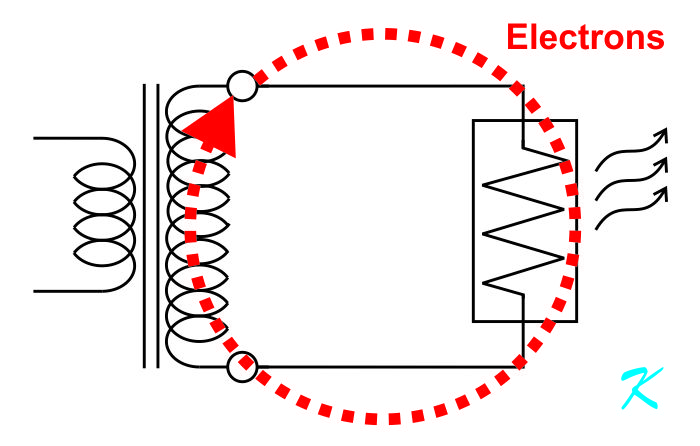It's interesting about the #6 green insulated wire getting hot. Free-air #6 copper wire should handle well over 100 amps without getting very hot. There had to be more than 100 amps of electrical current running through that wire.
A Circuit is a Circle
To have a complete electrical circuit, one where electrons are flowing, current has to travel:
- From one terminal on the power source
- Through one wire from the terminal to one side of the load
- Through the load to the other side of the load
- Through the other wire from the other side of the load to the other terminal on the source
- Through the source from the other terminal to the original terminal
This is the complete circle, and breaking the circle anywhere will stop the electron flow.
In a 3-phase circuit, other routes are added, but the quantity of electrons in any single-phase circuit shown, or any 3-phase circuit, never changes. The electrons still travel different routes, and eventually will still wind up coming back to where they started.
Ground is a Conductor
Electrons flowing into ground aren't lost forever like water flowing down a kitchen sink; any electrons flowing into ground will be seen again. If current is flowing through one ground connection (like the green wire), it has to be flowing through a second ground connection, somewhere else. When using ground as a conductor, that's part of an electrical circle (circuit).
Watts Law
In a resistor, according to Watt's Law, voltage times current equals watts. Your furnace has at least three resistors. When current flows through a resistor, the resistor turns that voltage-times-current (wattage) into heat.
A Wire is a Resistor
The #6 wire between neutral and ground is a resistor, and the wire-resistor in your circuit became hot enough to burn off the insulation. To do that, the wire has carried lots more current than it normally should.
Re-think ammeters; the #6 wire is your ammeter. If the wire is very hot, lots of current is flowing through the wire. Enough current is flowing through the wire that 200-amp fuses are being burned out.
Neutral is Supposed to be Grounded
Yes, it's supposed to burn out fuses. If there's a ground fault somewhere, the current flowing through the ground fault flows back through neutral-ground, back through the source (transformer windings count as a power source) and back through the fuse or circuit breaker, cutting the current flow.
Ground Faults Don't Have to be Copper-to-Metal Shorts
For information on non-linear resistances, like ground faults, see:
Is Water a Non-Linear Resistor?
When working with 120 volts, 208 volts, 480 volts, 13.8 k-volts, etc., a hand-held ohmmeter often doesn't cut it when checking for ground faults. Ground faults through copper-to-metal connections can easily be detected because the 3 to 9 volts used with a hand-held ohmmeter is sufficient. But the only reason the 3 to 9 volts sufficient is because the copper-to-metal connection is linear.
Other ground faults are non-linear and are often not detected by a hand-held ohmmeter.
- Carbon is a non-linear resistor
- Water is a non-linear resistor
- Worn insulation is a non-linear resistor
- Cracked or degraded insulation is a non-linear resistor
These non-linear resistances are only detected using an Insulation Detector, like a Megger.
I have watched as linemen checked a 3-phase, 13.8 k-volt, underground line to one of several TV and radio stations. Their hand-held ohmmeter didn't detect a problem, so they replaced the fuses. Reconnecting the fuses produced a 15-foot (5 meter) shower of sparks, and for a few minutes, the electrical-grid short blacked out 30,000 homes.
They had a non-linear short; they should have used a Megger.
Neutral and Ground
One of the reasons the neutral wire is connected to ground is to provide a first-ground connection before there is a second, powered ground fault. With a grounded neutral, if there is a powered ground fault, rather than someone being electrocuted, the fuse will be blown.
From your description, it looks to me that there is a major, non-linear ground fault, somewhere. The current that goes through that ground fault is enough to overheat a #6 wire, and burn out 200-amp fuses.
The #6 wire may be required to properly ground the circuit. If there is a ground fault somewhere, it may be required to keep the equipment from becoming electrically hot.
I suggest using a Megger when looking for the ground fault, the Megger can detect problems that an ohmmeter won't detect.
Also, before just removing the #6 wire, the reason that the wire is there in the first place needs to be investigated.
Douglas Krantz
